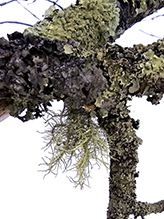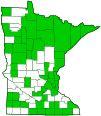Pom-pom Shadow Lichen
(Phaeophyscia pusilloides)
Conservation • Description • Ecology • Distribution • Taxonomy
|
|
||||||||||||||
Description |
Pom-pom Shadow Lichen is a common wreath lichen. It occurs in Europe, North America, Central America, and South America. It occurs in the United States and southern Canada east of the Great Plains, and there are just a handful of records in the west. It is common in Minnesota. Pom-pom Shadow Lichen is found in well-lit forests on nutrient-rich substrates. It is most common in secondary succession forests, but it is also found in climax forests. It grows on the bark of all kinds of trees. It rarely grows on rock. The vegetative body (thallus) is leaf-like (foliose). It is divided into radiating lobes forming a circular or irregular rosette that is usually up to ¾″ to 1 3⁄16″ (2 to 3 cm) in diameter. It is held to the substrate (bark) by black, unbranched, root-like structures (rhizines). The rhizines are often conspicuous from above, extending beyond the edges of the thalli. The primary lobes are usually long and narrow, they have straight sides, and they are non-overlapping. Occasionally some are irregularly rounded and are partially overlapping. They are flat and usually 3 ⁄256″ to 1⁄32″ (0.3 to 1.0 mm) wide, but sometimes up to 1 ⁄16″ (3 mm) wide. The upper surface is gray to grayish brown. The underside of the thallus is black, sometimes paler at the lobe ends. The upper and lower surfaces of the lichen are formed of tightly-packed, interwoven, fungal threads (hyphae) going in all directions (paraplectenchymatous). Hyphae are the tiny, thread-like structures that make up the body of the fungus. The paraplectenchymatous lower surface is one of the features that distinguish the genus Phaeophyscia from the genus Physcia. Cap-like, cortex-free areas of the thallus (soralia), at the ends of the lobes, produce powdery to granular reproductive growths (soredia). The underside of the thallus is black, sometimes paler at the lobe ends. Disk-like, spore-producing structures (apothecia) are uncommon to rare. When present, they are up to ⅛″ (3 mm) in diameter. The margin usually has a corona of black rhizines. |
Similar Species |
Ecology |
Substrate |
Trees |
Growth Form |
Foliose |
Habitat |
Well-lit forests |
Hosts |
|
Distribution |
||
|
Sources |
|
| 1/19/2025 | ||
Occurrence |
||
Common |
||
Taxonomy |
|
Kingdom |
Fungi (Fungi) |
Subkingdom |
Dikarya |
Phylum |
Ascomycota (Sac Fungi) |
Subphylum |
Pezizomycotina (Sac Fungi and Lichens) |
Class |
Lecanoromycetes (Common Lichens) |
Subclass |
Lecanoromycetidae (Shield Lichens, Sunburst Lichens, Rosette Lichens, and Allies) |
Order |
Caliciales (button lichens, rosette lichens, and allies) |
Family |
Physciaceae (rosette lichens, frost lichens, and allies) |
Genus |
Phaeophyscia (wreath lichens) |
Mycobiont |
Phaeophyscia pusilloides |
Photobiont |
green algae other than Trentepohlia |
This species was originally described as Physcia pusilloides in 1931. In a later review of the lichen genus Physcia (Moberg, 1977) the author erected the new genus Phaeophyscia for the 8 Finnish species species that were formerly in the Physcia orbicularis group, which lack atranorin, often have a brownish coloration, and possess ellipsoid conidia less than 4 µm in length. In 1978 Physcia pusilloides was moved to the genus Phaeophyscia. |
|
Subordinate Taxa |
|
|
|
Synonyms |
|
Physcia pusilla Physcia pusilloides Physcia suzai |
|
Common Names |
|
Pom-pom Shadow Lichen |
|
Glossary
Apothecium
An open, disk-shaped or cup-shaped, reproductive structure, with spore sacs on the upper surface, that produces spores for the fungal partner of a lichen. Plural: apothecia.
Foliose
Leaf-like; referring to lichens with thin, flat, leaf-like growths divided into lobes which are free from the substrate.
Hypha
A thread-like cell of a fungus that is the main mode of vegetative growth: the basic structural unit of a multicellular fungus. Plural: hyphae. Collectively, the hyphae of a fungus is the mycelium.
Rhizine
A root-like structure of a lichen that attaches the lower layer to the substrate.
Rosette
A radiating group or cluster of leaves usually on or close to the ground.
Soralium
On lichens, an area on the thallus with no cortex, usually on or near the margin or the tip of a lobe, on which soredia are produced. Plural: soralia.
Soredium
An asexual reproductive structure of a lichen in the form of a tiny dull granule on the thallus surface that can be easily brushed off. It consists of a cluster of algal cells (the photobiont) wrapped in fungal filaments (the mycobiont), but without an outer layer of protective tissue (cortex). Plural: soredia.
Thallus
In lichens: The vegetative body of a lichen composed of both the alga and the fungus. In liverworts: a flat, relatively undifferentiated plant body. Plural: thalli.
Visitor Photos |
||
Share your photo of this lichen. |
||
This button not working for you? |
||
Luciearl |
 |
Bristle beard lichen(hanging), also pom pom shadow lichen, powder tipped-shadow lichen? |
MinnesotaSeasons.com Photos |
||
|
|
|
|
|
|

Slideshows |

Visitor Videos |
||
Share your video of this lichen. |
||
This button not working for you? |
||
|
Other Videos |
||
|

Visitor Sightings |
||
Report a sighting of this lichen. |
||
This button not working for you? |
||
| Luciearl March 2023 |
Location: Lake Shore, MN Bristle beard lichen (hanging), also pom pom shadow lichen, powder tipped-shadow lichen? |
 |
MinnesotaSeasons.com Sightings |
||
|

Created: 1/19/2025 Last Updated: © MinnesotaSeasons.com. All rights reserved. |

